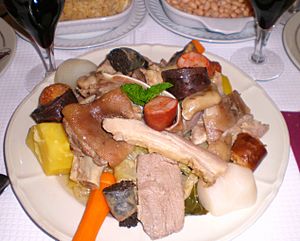Cozido à portuguesa facts for kids

Cozido à portuguesa (Portuguese boil) plate
|
|||||||
| Type | Cozido | ||||||
|---|---|---|---|---|---|---|---|
| Place of origin | Portugal | ||||||
| Associated national cuisine | Portuguese cuisine | ||||||
| Cooking time | 4 hours | ||||||
| Main ingredients | Vegetables, meats, Portuguese smoked sausages | ||||||
| 1178 kcal (4932 kJ) | |||||||
|
|||||||
Cozido à portuguesa (pronounced ku-ZEE-doo ah por-too-GEH-zah) is a very famous and traditional stew from Portugal. It's often called "Portuguese stew" in English. This dish is a type of cozido, which means a boiled meal.
Many different versions of this stew exist all over Portugal. It is seen as a very important part of Portuguese cuisine. Many people even consider it one of the national dishes of Portugal.
Contents
What is Cozido à Portuguesa?
Cozido à portuguesa is a hearty and delicious boiled dish. It is known for having many different ingredients cooked together. Think of it like a big, warm hug in a bowl!
This stew is a great example of traditional Portuguese cooking. It shows how different meats and vegetables can create a rich and comforting meal.
How is Cozido à Portuguesa Made?
Making Cozido à portuguesa involves boiling many ingredients together. This creates a flavorful broth and tender pieces of food.
The main ingredients usually include a mix of:
- Vegetables: You'll often find cabbage, beans, potatoes, carrots, turnips, and rice.
- Meats: Different kinds of meat are used. This can be chicken, pork ribs, bacon, parts of a pig like ears and trotters, and various pieces of beef.
- Smoked Sausages: Special Portuguese smoked sausages add a lot of flavor. These include chouriço, farinheira, and morcela (blood sausage).
All these ingredients are slowly boiled. This allows their flavors to blend together. The result is a rich and satisfying stew.
A Special Version: Cozido from the Azores
On São Miguel Island in the Azores, there's a very unique way to cook Cozido à portuguesa. This island is known for its volcanoes.
Here, the stew is cooked underground! The heat and steam come from the natural volcanic activity in the area. This method gives the stew a special taste. It's a great example of how local nature can influence cooking traditions.
See also
In Spanish: Cozido à portuguesa para niños

